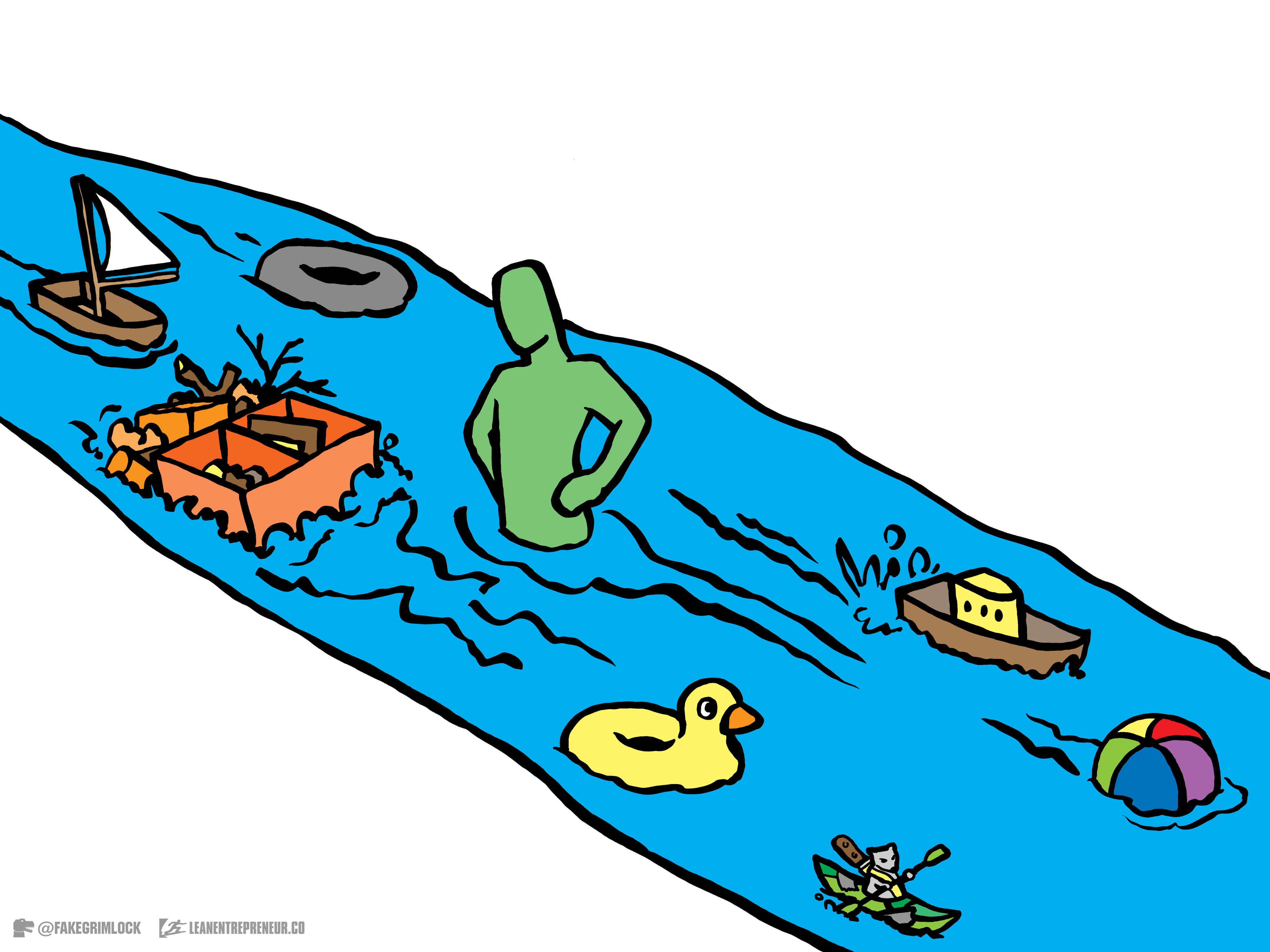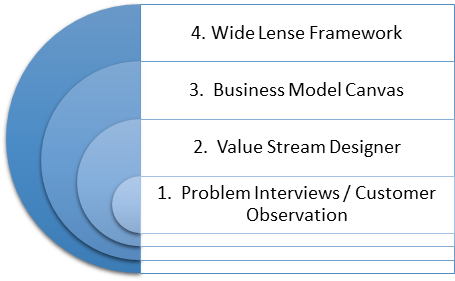I Know How to Run Experiments, Now What? (part 1)
The Lean Startup principle of rapid experimentation is spreading through enterprises like wildfire! At Intuit, we have at least 1,200 employees that have incredible experimentation capabilities. These folks are not only creating effective experiments, but extremely creative ones as well. One big problem is that many of these experiments are only occurring inside our two and five-day workshops.
As I follow up with teams long after the sessions, about 30% of the time I find that participants have not been able to identify where they can apply these new rapid experimentation skills in their daily work. I will eventually end up creating a module to help my students identify opportunities, but in the mean time, I thought I should create a quick series of posts to give you some specific situations to look for.
Here are three situations to be on the lookout for:
Our team is debating about which direction to head next
Imagine sitting in a team meeting and had a team member presenting a status update. They provide suggested next steps and then all hell breaks loose. It seems like everyone has an opinion or a dart to throw about where the project should head next.
This is usually a telltale sign that you can apply your new rapid experimentation knowledge. In this situation, you should capture ALL of the directions suggested, quickly prioritize the list and have each team member quickly test one of the suggestions before your next meeting. The entire team can come back to the meeting with real data to share and you can decide on the next direction to head.
We just made a crazy commitment (or got voluntold)
You join your boss for your regular 1-on-1 time and she has some “news” to share with you. He just got back from a staff meeting and is informing you that the team needs to be able to meet a fresh new goal within the next 6 months. You will need to increase a specific business metric (sales, conversions, NPS, etc) by 10%! He has a few ideas as to how you might be able to make this work.
This situation is ripe for the application of rapid experimentation. Your boss has some assumptions about the fact that these ideas will get you to the goal line. Take a few of the ideas and spend a few days quickly testing them. Come back to your boss with specific examples of how each idea may or may not work. Share with him the amounts you feel you can move the metrics with each idea and then FOCUS on 1-2 of the ideas to follow through on.
Our partners / vendors are not moving quickly enough
Unfortunately (or fortunately) in the enterprise, most development work is done through partner teams or external vendors. Because of this, they are usually interacting with you instead of directly connecting with the customer of your product. In addition to this disconnection, they are also trying to focus on delivering for multiple stakeholders.
What if you could make a very small request from your partner and/or vendor? With this request you can provide data showing a positive impact on your end customer and possibly even a rough ROI calculation that’s not pulled from thin air.
In my experience, the partner will be very happy to fit your small request into the front of their development queue. You have something that most of their other stakeholders do not have: proof!
Another great approach for this situation is to bring the partner / vendor along for the ride. Have them join you in the creation and execution of the experiments. Not only will the relationship get stronger, but they might be able to begin to apply the techniques as well. You can move quickly TOGETHER!
I will put together a few more posts with other situations I have spotted throughout my travels. In the meantime, what situations are you seeing as opportunities?
read moreLean Entrepreneur Value Stream + NPS = Customer Love

As many of you have already seen, I am a strong proponent of the use of the Net Promoter Score (NPS). It is an extremely powerful way to measure the value you’re providing to your customers. NPS helps you measure how often you are exceeding your customer’s expectations and provides a rough gauge to know how many customers may be talking (positively or negatively) to their friends about your product.
During the workshops and coaching sessions I’ve noticed a consistent pattern. Teams have no idea how to actually “delight” their customers (score a 9 or 10 NPS). The net promoter and delight concepts get tossed around like a ragged teddy bears. People understand what terms mean, but have no idea how to make the concept tangible.
Fortunately, Brant Cooper and Patrick Vlaskovits recently released their second book titled “The Lean Entrepreneur”. In this book they introduce a new tool called the Value Stream Designer (I’ll refer to it as VSD for the remainder of this article). I’ve had the pleasure of facilitating some workshops that utilize the tool.
In my opinion the VSD does a great job of helping teams keep from over-building their minimum viable product, hypothesize about what their customer actually expects and determine EXACTLY they are going to build! Additionally it facilitates getting your entire team on the same sheet of music as early as possible which is critical to your ability to be successful. I’m not going to go into detail about the actual mechanics of the VSD as Patrick and Brant already do a great job of covering that in The Lean Entrepreneur. I’ll stay focused on tips and tricks I’ve learned as a result of coaching many teams to use the tool.
Keep From Over-Building by Designing the Minimum Viable Product
Unfortunately, I have yet to see a single team that has been able to focus on building exactly what is necessary to solve their customer’s single problem right out of the gate. They get excited and want to build far more than is necessary. This observation includes many seasoned business professionals and Lean Startup experts. This problem is difficult to see because your team has their noses to the grindstone and are trying to move quickly. The VSD can help you solve this forest for the trees problem.
After you have a basic level of customer empathy; you know what problems you solve for each customer and think you know how your solution will fit into their workflow. I recommend that you print a large wall poster ($10 at Kinko’s) and have your entire team use post-its to fill in the VSD. You should start with the boxes inside the “Satisfied” section and then move on to the “Hopeful” section.

During this process you need to frequently push your team to get very specific about the values they write down. The more specific they can get the better. If it feels uncomfortable then you’re doing it right. Additionally, you should keep in mind that these values are nothing more than hypotheses. Every one of these are guesses that you’ll need to convert into facts using experiments with your target customers.
If you end up being correct about the hypotheses in these two boxes then you should have identified how you can ensure a net promoter score of 7 or 8 (neutral). Customers that make it to this point should have had their expectations met. We will get to the “Passionate” box (NPS of 9 or 10) later in the exercise.
Hypothesize About What Your Customer Actually Expects
As you filled out the “Satisfied” and “Hopeful” boxes on the VSD you will have come across the details of what you should be promising to your customers. You’ve just hypothesized about what impact you can make on them and how you will go about doing it.
You should now continue to move backward through the rest of the VSD (Convinced, Trusting, and Intrigued) and you will begin to dive into the exact touch points where the promises you identified above will initially be placed in front of your customers inside the conversion / sales funnel.
Continue thinking about the promises you had to make in the Satisfied and Hopeful boxes as you fill out the rest of the VSD.
Your final step to complete the VSD is to fill out the boxes inside “Passionate”. This section is typically based on a big insight gathered from watching your customers use your product over time and from experiments you’ve run on those customers. I recommend taking a starting guess about what things you might do to try to create a passionate customer, but it will require many experiments to determine what is actually valuable to the customer.
You now have a map of all of the hypotheses you’re making about the value proposition, funnel and how to actually delight your customer through the product. Additionally, this exercise has a tendency to create shared vision among the team members. Typically teams start out way too high level and it appears that the team has agreement on what they are actually building, but in reality they are all viewing the solution differently.
What about the Business Model Canvas?
One of the most painful things about learning these Lean Startup methodologies is the massive number of tools, frameworks, and puzzles available to teams (entrepreneurs and intrepreneurs). One of the tools that has taken our community by storm is the Business Model Canvas.
We all agree that in the early stages of a new endeavor we are looking for product-market fit. In other words, have we identified a specific customer, problem and solution that complement each other so perfectly that customers begin to pull the product from our hands?

I like to think of the Value Stream Designer as a tool to use to guide our first experiments and stay focused on the riskiest portions of the business model (customer + value proposition). Once you feel confident that your solution will really solve the customer’s problem and you can reliably attract customers then you should move on to looking at the entire business model (business model canvas).
After reducing risk in the larger business model canvas you should move to using the Wide Lens Framework to ensure that you don’t have any co-innovation and/or ecosystem risks in bringing your product to market.
If you can wrap your head about when to use each of these tools then you can safely pull it out of your tool belt at the right time and increase your chances of success. As always, I’d love to hear your feedback. Share how you are applying these tools in your world.
read moreTurbo Charge Enterprise Human Resources with Lean Startup
What we learned over the last year has been amazing. We’ve found that our employees feel more empowered to do their work, to innovate and to speak the language of leadership. They feel more in control of their careers and have many open doors to pursue as a result. On the flip side, employees are also more aware of the challenges in their own organizations when it comes to running rapid experiments, and have begun to ask more from their leadership in supporting them in this innovation journey.
 Just over a year ago I was hired as the first product manager for Intuit’s human resources group. I am responsible for products and services and will help employees take charge of their careers inside Intuit. As I’ve learned over the last year this is a pretty cutting edge position and there aren’t many enterprises applying this type of thinking inside HR.
Just over a year ago I was hired as the first product manager for Intuit’s human resources group. I am responsible for products and services and will help employees take charge of their careers inside Intuit. As I’ve learned over the last year this is a pretty cutting edge position and there aren’t many enterprises applying this type of thinking inside HR.
The first gap that we’ve noted over the last year is that most of our HR employees didn’t view their work as a product or a service. This gap caused us to view customer interactions as simple transactions. We didn’t look to measure how much we were delighting our customers, and in many cases didn’t even refer to our customers as customers.
Once we began changing this product mindset we quickly realized that many of us did not have the skills necessary to gather deep customer empathy. How could we focus our products & services for specific customers if we don’t understand what’s important to them? To resolve this gap we began leveraging our Innovation Catalysts to coach & mentor teams to strengthen these skills inside the organization. Additionally, we promoted one of our Innovation Catalysts to a product experience lead for the entire organization. The goal here was to turbo-charge the capabilities of the organization by having a single individual focused on it.
The second gap we identified was that HR employees were not using Lean Startup and Rapid Experimentation as a method of agile operation. Teams were operating in large siloes and the membership was not very cross-functional. Teams understood what it meant and why it was important, but not how to actually break their solutions down into assumptions and build super-small experiments to test them.
To try to solve this problem we utilized our Lean StartIN 2 day events to turbo-charge the teams. We had them bring their product or service to the class, and put them through an extremely intense 2 days of practical application of Lean Startup principles. [Read more about the course we created] This course helped HR employees better understand the behaviors of their customers, helped them refine their customer segments, and ultimately reduce risk in their projects.
With all products (including our Lean StartIN course) it is important to understand how it impacts your customer. In our case we followed up with participants of the course a month after the completed it to find out how it had impacted them personally. In addition to the positive benefits I described at the beginning of the post, we also identified that participants would get back to their daily work and feel that leadership was not making decisions fast enough and not clearing a path for them. They were moving faster than the rest of the organization! We’re working to address that issue separately and I won’t elaborate on it more here.
Now that the teams were moving quickly and focused on more specific customer segments we needed to solve another key problem we heard from our customers. What we were hearing from the business units was that they feel HR is buying / building tools and pushing them out into the organization. They felt that HR was not really working with them to solve specific issues.
The next phase of our journey is to identify how we can get the business units to pull us into key issues and partner with them to solve the issues using our products and services (or with new ones). As with any journey you have to keep making consistent steps and the adventure is in to trip and not arriving at the destination.
What are you seeing in your organizations? Post in the comments below.
Lessons Learned:
- Treat your HR teams like product teams – They should be able to produce positive ROI for their customers (employees) just like a product team. They should be able to move quickly just like a product team. They should create value for their customers just like a product team.
- Your employees are your customers – You should strive to delight them just as you would an external customer. If you can delight your employees then they can delight your external customers.
- You can improve employee engagement by empowering employees – Getting employees to behave like intrapreneurs, move quickly and make decisions based on customer data will put them head and shoulders above their peers. They will have the tools they need to solve any problem in any organization.
Enterprise Business Model Canvas for non-product teams
After coaching hundreds of startup teams and over 300 Intuit Enterprise Lean Startup teams I have come to really appreciate the simplicity and power of Alexander Osterwalder’s Business Model Canvas. I find that many internal product teams (IT, HR, Finance, etc.) tend to have difficulty translating the business model canvas for their internal products and services. Historically these teams tend to think in terms of projects and not products and customers.
Fortunately, Alexander’s work is very solid and translates really well with a few simple tweaks to how you view the 9 boxes on the canvas. Simply asking yourself a handful of different questions can quickly help you increase your ability to communicate the importance of your new product or service to senior leadership in your enterprise.
Customer Segments
In my experience, this tends to be one of the harder boxes for teams to get their heads wrapped around. I would suggest that you start by applying Brant Cooper & Patrick Vlaskovits’ persona work from Lean Entrepreneur to create a persona of your most likely early adopter. Who is the one person that will tear the solution out of your hand fastest?
Unfortunately, many internal teams tend to think that “every employee” will be their customer. While in some situations it may be true, you should really push yourself to identify who will benefit from it most. Once you begin hitting a wall with narrowing in on your customer, I would suggest that you swap to using anti-segments. Who looks like your perfect customer, but will actually be a terrible customer? Maybe they will require tons of additional support or hand-holding. Applying this anti-segment lens should also help you focus and find a starting point for your product.
In some situations teams have a product or service where their customer base is quite small. Maybe it only serves a department or two in their company. In this case it becomes fairly straightforward to create the initial customer persona, but it will be important to make sure there aren’t other customers in corners of the enterprise that are not on your radar. This tends to happen with teams that are setup in a highly distributed and cross-functional organization.
For example, an enterprise where there is a central IT organization and each business unit also has IT teams. Frequently, similar solutions are being implemented across business units with the left hand not talking to the right.
Another area to focus on during this exercise is to think about influencers, approvers, and corporate anti-bodies that you will need to work with to make this product or service successful. Steve Blank has documented this really well in The Startup Owner’s Manual. He goes into detail about how to think through all of these different customer types and how they apply in this context. You’ll need to work with all of them so you might as well spend some time making sure you understand how deep the pool is before you jump in head first.
Value Propositions
You’ve probably heard this a million times, but you need to think about your Minimum Viable Product. Not cheap, not fast, not crappy. Minimum! Which are the minimum features you’ll need to be able to satisfy the problems that your customers have?
Be sure to document in very specific terms what the solution will be. Will it be a web site, a mobile application, a new IVR application? This is important as you’ll need to be sure your entire team is aligned on what the solution looks like from a very early stage.
This is another area where you can leverage The Lean Entrepreneur. The value stream exercise Patrick & Brant outline in the book works wonders for helping to identify the MVP for this product or solution. For those of us that utilize the Net Promoter paradigm, the exercise will also help you think through what your customer actually expects so you can then go above their expectations and possibly have them promote your product to their colleagues. This is just as valuable for internal teams as it is for regular product teams. Don’t underestimate the power of having colleagues talk positively about the product / service you delivered.
Customer Relationships
This box is one that is frequently overlooked by internal teams as they don’t tend to have marketing backgrounds or focus. Regardless, it is of paramount importance as overlooking this can put you in the position of trying to justify the existence of this product or service later on down the road!
Many large organizations tend to default to the use of positional power to roll out new products and services. The “Use this because we told you to” syndrome is all too often prevalent and the default marketing tactic. How can you implement this solution without the use of positional power? Have you interacted with your customers enough to know if this new product or service will confuse them? Will they simply stop using the old one? What does the change management journey look like?
Channels
How does your customer expect you to deliver / distribute the value proposition to them? Think about alternative ways that you can deliver your value proposition (aside from what’s typical). I’ve seen teams that have taken pages from Apple and begun offering computer help desk services in the cafeteria and the employees LOVED it. This is a great example of exploring alternative distribution channels. Instead of waiting for the help desk tickets to come to them, the employees went out to their customers.
Revenue Streams
All too often employees default to skipping this extremely important box on the canvas. They say things like “We’re not going to be charging other employees to use this software”. By simply asking yourself: What is the positive business impact of this project? You can set yourself up for success with upper management. When you come to them with a clear understanding of the positive impacts you’ll create for the business it makes the conversation so much easier. If this new solution creates more efficiency, saves time or increases customer satisfaction, how do those benefits translate to the bottom line?
Remember, everything you place on the canvas is nothing more than an educated guess. You’ll need to test each of these hypotheses and identifying key business metrics you’re trying to move with this product / service will keep you and your team honest. Killing a product / service that’s not up to snuff can be just as valuable as implementing one that’s successful.
Key Activities
The key activities tend to be projects you’ll need to execute as well as ongoing activities after implementation. What additional work will your team be taking on as a result of this new solution?
Key Resources
Which resources do you need (people, systems, platforms, etc) from inside or outside your enterprise? Will these be temporary resources or permanent? How can you prove the Revenue Streams box and use that to convince these other teams that they should move your project up in their queue?
Key Partners
What will you need from other teams? If they are also delivering for the same customer then they will be partners, otherwise they will probably be key resources.
Cost Structure
This final box on the business model canvas will help you to think through how to begin answering questions from your management teams like “What is the ROI on this new product or service?” Once you answer how much this will cost, how many man hours might be invested, etc. you’ll contrast that with the values you’ve identified in the Revenue Streams to identify a rough ROI. Again, you’re taking an educated guess and need to prove these out.
Once you have the initial costs documented, you should start to think about the ongoing costs and resources needed to support this product / service. For example, a gas station could offer to clean windows, check oil, fill tires, etc while a customer fills up. The cost in providing these services could make the business unprofitable. As an internal team you should think through the total time it takes to perform a task or the total number of hours as good metrics to use to measure the cost structure and support the offering.
As you can see, utilizing the business model canvas inside the enterprise is actually fairly straightforward and can give intrapreneurs some very powerful ways to communicate with your management team as well as track your progress toward a new product or service that is delightful to your customers.
I’d love to hear how you’re able to apply this in your organization in the comments below!
read more







Connect With Me